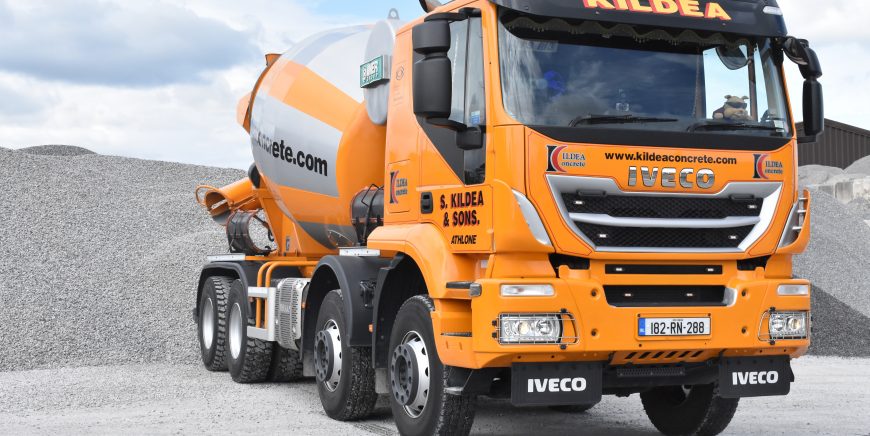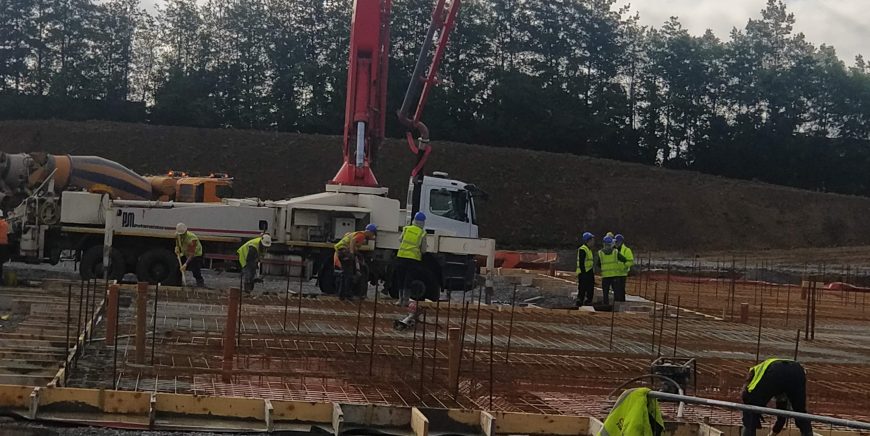




Ready Mix Concrete
In volume terms, twice as much concrete is used worldwide than all other construction materials combined. It has been used in extreme climates and on the most demanding engineering projects and as a result its physical properties are tried, trusted and well understood by engineers. In Ireland, ready mixed concrete is manufactured to “ISEN 206-1 :2002 Concrete – Part 1 : Specification, Performance, Production and Conformity” in fully computerized, automated batching plants, so that the end product is delivered to a high standard. When engineers build with concrete, they build with confidence. By varying the mix design, to include various additives, engineers can design-in an extensive range of physical properties to cater for almost any physical, structural or site requirement. Concrete is without doubt, the most flexible of all building material.
The design of ready mix concrete will depend on the physical and structural requirements and on the specific conditions in which it is being laid. Ready Mix concrete is available in a range of ‘workabilities’ to suit the different methods of placement, including pump mix. Concrete will also be specified to have a specific ‘cube strength’ which normally varies between 10N/mm’ and 60N/mm’. Durability is a key design factor and this is designed relative to the ‘exposure class’ (i.e. for a corrosive or non-corrosive environment) and to the required ‘working life’ of the concrete.
Mix Design
The basic constituents of concrete are cement, aggregates, water and admixtures. These materials combine and harden when water is added, in a chemical reaction known as ‘hydration’. The properties of the hardened concrete vary dramatically depending upon the relative amount and specific characteristics of the constituents. Good ‘proportioning’ of the constituent materials and a detailed knowledge of the physical properties of these materials is therefore critical to achieving an end product which is fit for the purpose for which it is designed.
Concrete consists of a ‘cement water paste’ and ‘aggregates’. The cement water paste is the ‘active ingredient’ and the aggregate is the ‘inactive’ or inert ingredient. The structure of the concrete can be visualized as a mass of aggregate particles suspended in and separated by the cement. The ‘cement water paste’ consists of cement particles suspended in water. The greater the proportion of water to cement (i.e. the ‘water cement ratio’) the greater the distance between the suspended cement particles will be when the water evaporates in the process of hydration. The greater the distance between cement particles the more porous (permeable) the hardened concrete will be and therefore it is clear that the quantity and quality of the paste plays a key role in determining the properties of both the fresh and hardened concrete.
Note:
The ‘consistence'(workability) and ‘cohesiveness’ of fresh concrete is determined by the lubricating effect of the paste, which in turn is governed by the quantity and quality of the latter.
The ‘strength’ of the hardened concrete will be limited by the strength of the paste, since mineral aggregates are practically always far stronger than the paste in which they are suspended.
Permeability (and consequently durability) will be governed by the quality and continuity of the paste, since mineral aggregates are generally practically impermeable.
The most significant factors, which must be taken into consideration in concrete proportioning are the water content, the cement content, the water cement ratio, the consistence of the fresh concrete and admixtures.
Admixtures
Admixtures are sometimes used in order to improve certain qualities in a concrete mix. The most frequently used are: air entraining agents, plasticizers, and retarders. Air Entraining Agents: Entrained air reduces the water requirement of concrete mixes and improves the consistence and cohesiveness of fresh concrete. It also improves the frost resistance and general durability of hardened concrete, and its use is therefore recommended for all concrete which will be exposed to destructive weathering agencies.
Plasticizers: The water content can be reduced while maintaining the same cement content and consistence; this results in a reduced water / cement ratio by about 10%. And therefore increased strength and improved durability.
Retarders: The length of time concrete remains workable depends on its temperature, consistence class, water / cement ratio and on the amount of retarder used. While the early strength of concrete is reduced by using a retarder which may affect formwork striking times, the 7 and 28 day strengths are not likely to be significantly affected.
Specialised Concrete Mixes
Fibre Mesh
Steel Fibres
Foamed Concrete
Water Proofer
Slip Form Kerb
GGBS
Retarded Mixes
SCC (Self Compacting Concrete)
Air Entrained Concrete
Accelerated Concrete
Low Shrinkage Concrete
Pumped Concrete
More available – for other specialized concrete not on the list contact us

